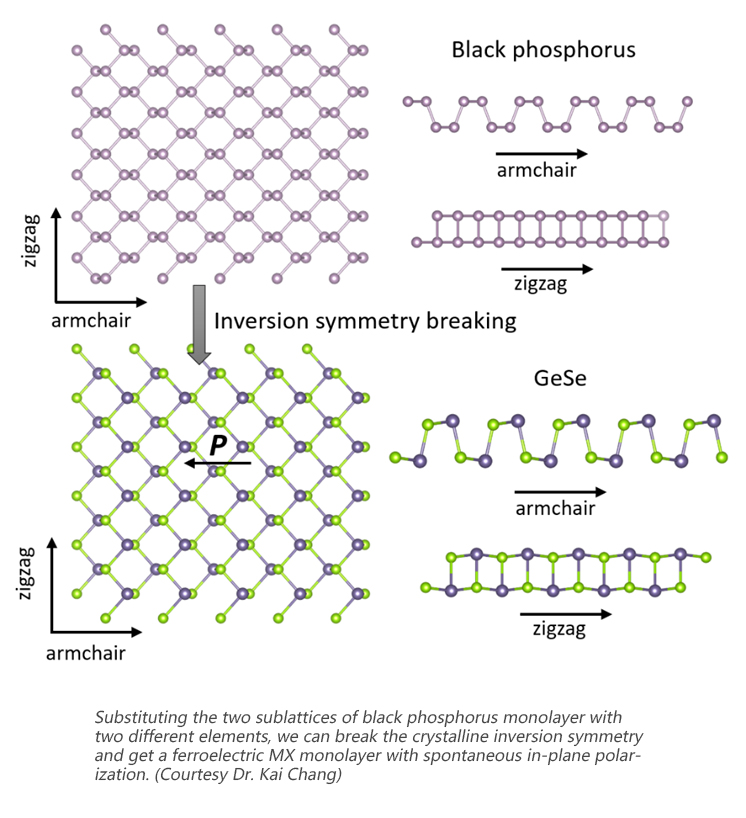Dr. Kai Chang and colleagues write on group-IV monochalcogenide monolayers in Reviews of Modern Physics
2021/05/18
Recently, Dr. Kai Chang, a Principle Investigator of BAQIS, has published a Colloquium article entitled "Physical Properties of Group-IV Monochalcogenide Monolayers" [1] in Reviews of Modern Physics, a world-renowned top-tier review journal in the field of physics, as one of the corresponding authors, together with his colleagues: Prof. Barraza-Lopez (co-corresponding author) and Dr. John W. Villanova from Department of Physics, University of Arkansas; Prof. Benjamin M. Fregoso from Department of Physics, Kent State University; and Prof. Stuart S. P. Parkin from Max Planck Institute of Microstructure Physics.
In this article, the authors systematically review the latest experimental and theoretical progresses in the field of MX monolayers, including the crystalline structure and chemical bonding properties of these 2D semiconductors, the synthesis methods, their ferroelectric switching behaviors, linear elastic properties, auxetic behavior, piezoelectricity, structural degeneracies, anharmonic elastic energy, structural phase transition, pyroelectric behaviors, electronic structures including valley and spin properties, and optical properties.
Group-IV monochalcogenide monolayer semiconductors with the chemical formula of MX (M = Ge, Sn, Pb; X = S, Se, Te) are a category of two-dimensional (2D) quantum materials with rich novel physical properties and promising potential for applications. By tuning multiple parameters including chemical composition, strain, external electric and optical fields, these materials exhibit a kaleidoscope of interesting behaviors, such as in-plane 2D ferroelectricity, ferroelasticity, electron valley polarization, valley Hall effect, persistent spin helix and different topological electronic structures, making them useful for designing and fabricating future non-volatile quantum devices.
As members of the big family of 2D materials, MX monolayers share many similar properties as their 2D semiconductor cousins, like atomically thin, sensitive to field tuning, high flexibility, and of course, van der Waals inter-layer coupling. What makes MX monolayer special is their spontaneously broken crystalline inversion symmetry, which leads to a switchable electric polarization. Despite noncentrosymmetric 2D semiconductors like MoS2 monolayers have been discovered earlier, switchable polarization has not been achieved until the experimental realization of several 2D ferroelectric materials in 2016, including single-layer-thick SnTe, an example of MX monolayer.

More interestingly, together with strong spin-orbital coupling, the electronic valley and spin degeneracies of MX monolayers are also lifted, giving rise to the aforementioned exotic electronic structures.
"This category of materials offers a huge playground for almost everyone in the field of condensed matter physics. You can always find something you are interested in," said Dr. Kai Chang, Principal Investigator of Low-Dimensional Quantum Materials Team in BAQIS.
"A vigorous push for the deployment of atomically-thin, two dimensional ferroelectrics has taken place over the past five years," said Prof. Barraza-Lopez. This field is expected to grow even quicker in the next few years.
About Dr. Kai Chang:

Dr. Kai Chang dedicates in the molecular beam epitaxial growth and scanning tunneling microscopy characterization of 2D ferroelectric semiconductors, and has achieved a series of pioneering studies in the field of MX monolayers [2]-[7].
Dr. Kai Chang's team in BAQIS will focus on the in situ growth and characterization of the in-plane and out-of-plane heterostructures between MX monolayers, superconducting materials and topological materials. Their studies will consolidate the material foundation for the fabrication of topological quantum computing devices and high-density non-volatile 2D ferroelectric memories.
Work at BAQIS was funded by Beijing Municipal Government and National Natural Science Foundation of China. Dr. Kai Chang's early experimental works on MX monolayers were carried out in Tsinghua University and Max Planck Institute of Microstructure Physics.
About Reviews of Modern Physics:
 Reviews of Modern Physics (abbreviated RMP) is a quarterly peer-reviewed scientific journal published by the American Physical Society. It was established in 1929 and the current editor-in-chief is Michael Thoennessen. The journal publishes review articles, usually by established researchers, on all aspects of physics and related fields. The reviews are usually accessible to non-specialists and serve as introductory material to graduate students, which survey recent work, discuss key problems to be solved and provide perspectives toward the end. RMP is arguably one of the most, if not the most, prestigious, authoritative and highly impacting journals in the field of physics.
Reviews of Modern Physics (abbreviated RMP) is a quarterly peer-reviewed scientific journal published by the American Physical Society. It was established in 1929 and the current editor-in-chief is Michael Thoennessen. The journal publishes review articles, usually by established researchers, on all aspects of physics and related fields. The reviews are usually accessible to non-specialists and serve as introductory material to graduate students, which survey recent work, discuss key problems to be solved and provide perspectives toward the end. RMP is arguably one of the most, if not the most, prestigious, authoritative and highly impacting journals in the field of physics.
References:
[1] Rev. Mod. Phys. 2021, 93, 011001.
[3] Adv. Mater. 2019, 31:1804428.
[5] Phys. Rev. Lett. 2019, 122:206402.
[6] APL Mater. 2019, 7:041102.
[7] J. Appl. Phys. 2020, 127:220902.
 中文
中文 Email
Email QCloud
QCloud Log in
Log in
